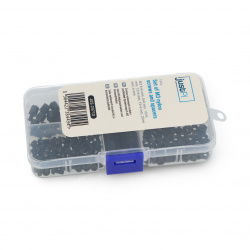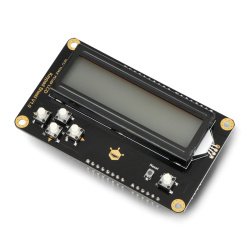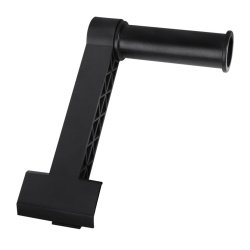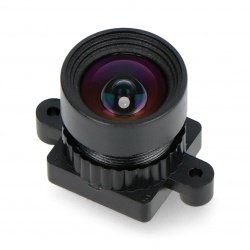The thermal imaging camera is a device using the latest technology. It shows the ability to change infrared into an image. This allows us to make measurements and observe temperature differences. Thermal imaging cameras have a wide range of applications. They prove themselves in many situations, which is due to their exceptional capabilities. They are used, among others, in intelligent image recognition systems, such as motion detection systems. They are used for monitoring vast areas, including parking lots, fields and storage halls. Thermal cameras also fulfill the function of external protection systems, as they allow to detect a threat even in the dark and with limited visibility. In addition, they can be used to monitor the interiors of buildings and public places of use and to detect technological defects without any invasion. Thermal cameras are also known as infrared cameras or thermographic cameras. Check out which cameras are offered by Botland!
Thermovision cameras
Thermal imaging camera - FLiR Lepton Dev Kit V2 - SparkFun KIT-15948
A set containing the Flir Lepton V2 thermal imaging camera , and a board to facilitate its connection. The Lepton LWIR radiometric module used in the device has a resolution...- Sale
- SPECIAL OFFERS
Thermal imaging camera - 256x192px - UNI-T UTi260B
A handheld thermal imaging camera from UNI-T that enables accurate temperature measurements and real-time thermal imaging display . The camera can detect a wide range of...Devices for imaging temperature distribution
Mid-infrared imaging is similar to how regular cameras work. Thermography cameras differ in special, dedicated optics - the lenses of these devices cannot be made of glass because it blocks infrared. Instead, special materials are used, such as germanium, calcium fluoride or crystalline silicon. There are also other detectors using low-gap semiconductors, such as indium antimonide, indium arsenide, mercury cadmium telluride (MCT), lead sulfide or lead selenide. On the other hand, the reading electronics is similar and presents the user with an image - black and white or with the so-called pseudocolor, where individual colors correspond to increasing temperatures.
Principle of operation of thermal imaging devices
A black body is an idealized physical concept of a body that absorbs all electromagnetic radiation regardless of its frequency or angle of incidence. At the same time, it emits electromagnetic radiation depending on its temperature. This relationship is described by the Planck distribution. At room temperature, the maximum of this distribution occurs in the far infrared, moving towards visible light as the temperature increases. Due to the shape of the Planck distribution, as the temperature increases, the amount of infrared radiation emitted by a given body also increases. Thermal imaging cameras collect this infrared radiation (usually operating in the range of 7 to 14 μm), just like regular cameras collect visible light, thanks to which the viewed image has different colors.
The use of a thermal imaging camera
A thermal imaging camera can be used in many different ways. Devices of this type are used, among others, precise for measuring temperature on the surfaces of objects, thanks to which you can easily locate thermal losses invisible to the naked eye. In addition, thermal cameras are used in industry, machine operation control, and vehicle mechanics. They are also used by electronics, electricians and DIY enthusiasts.
Simple IR modules for mobile devices
Our store offers a wide selection of economical and compact thermal imaging modules dedicated to connecting to smartphones, tablets and other portable devices. Communication between devices takes place via an electrical signal. Thanks to this, these modules are significantly cheaper than their complete cousins, while providing similar imaging quality. This makes thermography popular - even hobbyists can afford to buy this type of device and use it with their smartphone.
Thermography camera applications
Thermal imaging cameras have a number of applications in many areas of industry, as well as defense and science. Thermography is often used in electronics to monitor the operation of power devices and to detect faults in energy systems. Thanks to the use of thermal imaging devices, it is possible to quickly detect excessively hot elements and diagnose faults. In construction, thermography is used to check the correctness of thermal insulation of buildings and to issue energy certificates. Thermal imaging cameras are also used by the police and the army - they allow, among other things, locate people in complete darkness. Thermography is also used to monitor the natural environment, pollution levels, health of farm animals, etc. This technology is of great importance in the modern world. In the cameras and recorders category you can also find practical IP cameras, sports cameras, camera recorders, as well as web cameras, inspection cameras and a wide selection of accessories.
Thermal imaging cameras
In an advanced electronics service, a thermal imaging camera is used to detect and locate faults that lead to overheating of components or traces on a printed circuit board . A good choice will therefore be a model that allows for close-up imaging - for example, the Seek Thermal Compact Pro module allows you to focus from 15 cm.
The thermal camera - using a predefined color scale - shows the temperature distribution of the surface of the imaged object. A palette is often used in which the warmest objects are white, while cooler elements are presented in yellow, orange, red and purple (up to black in the case of surfaces with the lowest temperature in the tested range).
A thermal imaging camera is a specialized device that allows you to obtain a color image of an object, where the color of each pixel indicates the temperature of the examined surface at a given point. In other words, a thermal imaging camera differs from a regular camera in that it uses invisible, thermal infrared radiation instead of visible light.




















































































































































































































































































































































